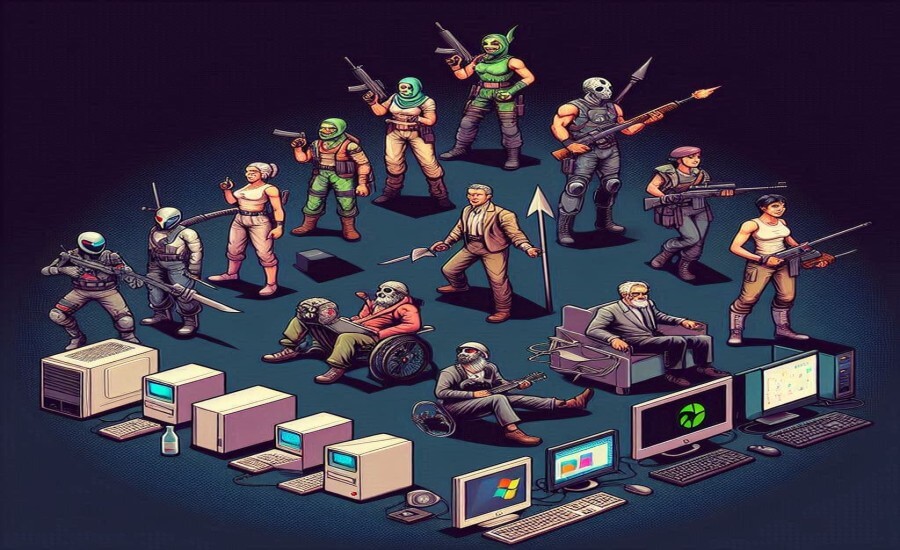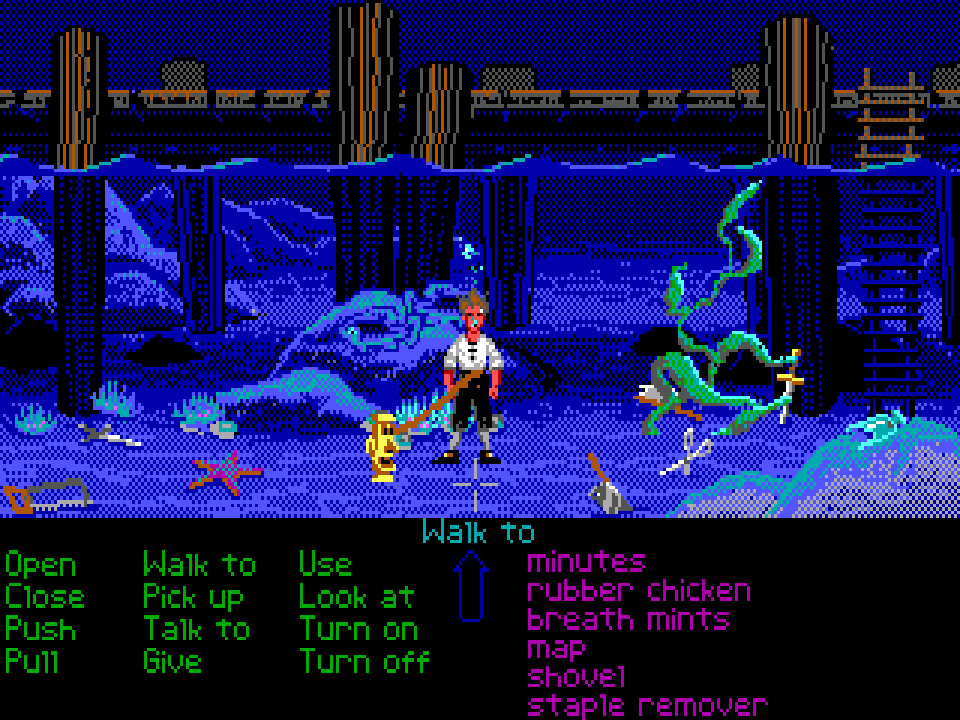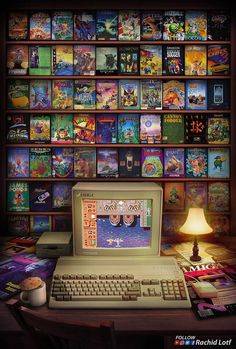
Remember the glow of a monochrome monitor? The cryptic C:\> prompt? The whirring and clicking of a floppy drive loading… something? Maybe it was a text adventure where your imagination painted the world, or perhaps simple blocky graphics that represented spaceships or castles. That blinking cursor was a portal, the keyboard your interface to nascent digital realms. You are there, at the command line frontier of pc gaming history.
The Genesis Era: Text, Beeps, and Imagination (Late 1970s – Mid 1980s)

In the earliest days of personal computing (Apple II, Commodore 64, IBM PC), gaming was primitive by today’s standards, yet revolutionary for its time. Often, games were text-based adventures like Zork or Colossal Cave Adventure, where the story unfolded through written descriptions, and you interacted by typing commands (“GO NORTH”, “GET LAMP”). Graphics, when present, were rudimentary – CGA (4 colors) or EGA (16 colors) offered blocky visuals that required significant imagination to interpret.
Sound often consisted of simple beeps and boops from the internal PC speaker. Joysticks existed, but keyboard controls were paramount. These early games, often programmed in BASIC or ported from other systems, were less about technical spectacle and more about puzzles, exploration, and the novelty of interacting with a digital world.
Tech Spotlight: Text Adventures (Zork, Colossal Cave Adventure)
These games relied entirely on descriptive text and player commands. They fostered reading comprehension, problem-solving, and, crucially, imagination. The lack of visuals wasn’t necessarily a drawback; it allowed players to build vast, detailed worlds in their minds.
Parallel Developments
Arcade gaming was booming (Pac-Man, Donkey Kong). Early home consoles like the Atari 2600 offered graphical (though basic) experiences. The PC was primarily seen as a business or productivity tool, with gaming as a secondary, often enthusiast-driven, pursuit.
User Experience Snapshot
Playing involved typing commands, carefully reading descriptions, mapping environments on graph paper, and a lot of trial and error. The reward was solving a clever puzzle or discovering a new area in the text-based world. The PC speaker’s limited sounds were surprisingly effective at creating tension or signaling events.
The Breakthrough Years: Pixels, Sound Cards, and Shareware (Late 1980s – Early 1990s)

The late 80s and early 90s saw PC gaming truly come into its own. VGA graphics brought a stunning palette of 256 colors, allowing for much more detailed and appealing visuals. Sound cards, pioneered by AdLib and perfected by Creative Labs’ Sound Blaster, moved beyond simple beeps to offer synthesized music and digitized sound effects, adding immense atmosphere. The mouse became a standard input device, crucial for graphic adventures and emerging strategy games.
This era was fueled by iconic genres: sophisticated graphic adventures from Sierra (King’s Quest) and LucasArts (Monkey Island), complex flight simulators (Wing Commander), and the birth of the first-person shooter. Crucially, the Shareware distribution model, championed by companies like Apogee (later 3D Realms) and id Software, allowed players to try the first episode of games like Commander Keen, Wolfenstein 3D, and the earth-shattering Doom for free, spreading PC gaming like wildfire.
Getting these games running often involved wrestling with AUTOEXEC.BAT and CONFIG.SYS files to manage precious conventional memory – a rite of passage for DOS gamers.
Tech Spotlight: Sound Blaster (Creative Labs, 1989)
The Sound Blaster card became the de facto standard for PC audio. Its ability to play digital audio samples and FM synthesis music transformed games from silent text or beeping affairs into immersive auditory experiences. Hearing digitized speech or realistic sound effects for the first time was revelatory.
Milestone Markers
- VGA Graphics: 256 colors become the standard, enabling detailed pixel art.
- Sound Cards: AdLib and Sound Blaster bring music and sound effects.
- Shareware: Fuels rapid growth and distribution (Commander Keen, Wolf3D, Doom).
- Genre Defining Games: King’s Quest, Wing Commander, Dune II, Doom.
- The Pain of DOS Memory Management: Learning about HIMEM.SYS, EMM386.EXE, and conventional memory.
User Experience Snapshot
Installing games meant swapping multiple floppy disks, sometimes a dozen or more! Booting up often required custom configurations. But the payoff was huge: exploring colorful worlds in King’s Quest, feeling the rumble of your ship in Wing Commander, or the adrenaline rush of blasting demons in Doom with Sound Blaster audio roaring. Do you remember the specific sound of the BFG 9000 firing?

The Refinement Period: 3D Acceleration and Early Online Play (Mid-1990s – Late 1990s)

The mid-to-late 90s were defined by two major shifts: the transition to Windows 95 as a gaming platform (thanks largely to DirectX standardizing APIs) and the explosive arrival of 3D acceleration. Games like Descent, Quake, and Tomb Raider pushed graphical boundaries, but truly unlocking their potential required dedicated 3D graphics cards.
This sparked the first great hardware arms race for gamers. Companies like 3dfx Interactive (with their legendary Voodoo cards), Nvidia (Riva TNT), and ATI (Rage) battled for dominance. Owning a Voodoo card and running GLQuake felt like magic, transforming blocky pixels into smoother, textured worlds with filtered lighting. CD-ROMs replaced floppy disks as the primary distribution medium, allowing for larger games with pre-rendered cutscenes and CD-audio soundtracks.
This era also saw the beginnings of mainstream online multiplayer gaming via dial-up or early broadband, with Quake popularizing deathmatch and early MMOs like Ultima Online and EverQuest building persistent online worlds. LAN parties became a cultural phenomenon.
Tech Spotlight: 3dfx Voodoo Graphics
The Voodoo chipset (and later Voodoo2) became synonymous with the first wave of 3D acceleration. Its Glide API offered incredible performance gains in supported games (Quake, Tomb Raider, Unreal), making smooth, textured 3D graphics a reality for consumers and setting the stage for future GPU development. Owning one was a badge of honor for PC gamers.
Innovation Timeline (Conceptual)
- Mid-90s: Windows 95/DirectX adoption, CD-ROM standard, early 3D games (Descent, Quake).
- 1996-1998: 3D accelerator cards boom (Voodoo, Riva TNT), widespread internet adoption begins, early MMOs launch (Ultima Online 1997).
- Late 90s: Maturing 3D graphics, LAN parties common, online gaming grows.
Price Point Perspective
Dedicated 3D accelerator cards were expensive, often costing $200-$300 or more (a significant amount in the late 90s), creating a divide between those who could afford the cutting edge and those stuck with software rendering. This began the cycle of needing regular hardware upgrades to play the latest titles.
User Experience Snapshot
The jump to hardware-accelerated 3D was breathtaking. Games went from slideshows to fluid experiences. Installing from CDs was faster than floppies. Dialing up for an online deathmatch in Quake or joining hundreds of others in Ultima Online felt like stepping into the future, even with lag. LAN parties, lugging heavy CRT monitors and PCs, created intense, social gaming experiences.
The Revolution: Broadband, Steam, and the Modding Boom (Early 2000s – Late 2000s)

The new millennium cemented PC gaming’s evolution. Broadband internet became increasingly common, transforming online gaming from a niche pursuit into a core feature.
Massively Multiplayer Online Role-Playing Games (MMORPGs) exploded, led by the phenomenal success of Blizzard’s World of Warcraft (2004), which became a cultural touchstone.
Valve Corporation changed game distribution forever with the launch of Steam in 2003. Initially just a way to update Valve’s own games like Counter-Strike, it evolved into a digital storefront, library manager, and social platform, eventually becoming the dominant force in PC game sales.
Landmark titles like Half-Life 2 (2004) showcased advanced physics, facial animation, and graphical fidelity, requiring powerful DirectX 9-capable GPUs (like Nvidia’s GeForce FX/6 series or ATI’s Radeon 9000/X series). The modding community flourished, turning games like Half-Life and Unreal Tournament into platforms for countless user-created variations, some of which became standalone hits (Counter-Strike, Dota).
Tech Spotlight: Steam (Valve, 2003)
Steam revolutionized PC game distribution. It offered automatic updates, digital purchases tied to an account (controversially, at first), built-in server browsers, friend lists, and later, achievements, cloud saves, and community features. Its success paved the way for the decline of physical retail and the rise of digital-first gaming.
Industry Voice
Figures like Gabe Newell (Valve), John Carmack (id Software), and Tim Sweeney (Epic Games) became influential voices, driving innovation in game engines, graphics technology, and distribution models.
Unexpected Consequences
The rise of Steam led to debates about digital ownership (do you truly own your games?). The success of WoW led to a flood of “WoW clones.” The ease of modding sometimes created legal gray areas but also fostered incredible creativity and talent.
User Experience Snapshot
Broadband meant low-latency online multiplayer became the norm. Installing games digitally via Steam was incredibly convenient compared to managing CDs/DVDs. Joining massive raids in WoW or intense tactical battles in Counter-Strike defined online social gaming. Modding games extended their lifespan infinitely. Upgrading your GPU felt essential to keep up with demanding new titles.
[UI EVOLUTION SUGGESTION: Compare an early Steam client interface with the modern version, showing the expansion of features.]
The Modern Landscape: Digital Dominance, Indie Power, and Beyond (Early 2010s – Present)

Today, PC gaming is more diverse and accessible than ever, yet also more complex. Digital distribution is king, with Steam facing competition from platforms like the Epic Games Store, GOG, and publisher-specific launchers (Battle.net, EA App). Free-to-play games and “Games as a Service” models, relying on microtransactions and ongoing updates, dominate large parts of the market (Fortnite, League of Legends, Genshin Impact).
The indie scene has exploded, enabled by accessible game engines (Unity, Unreal Engine) and digital platforms, leading to incredible creativity and innovation (Minecraft, Stardew Valley, Hades, Among Us). Esports has grown into a global phenomenon with professional leagues, massive prize pools, and huge viewership.
Cutting-edge technology continues to push boundaries: high-refresh-rate monitors (144Hz+), VR and AR headsets offering new levels of immersion, real-time ray tracing delivering photorealistic lighting, and powerful multi-core CPUs and NVMe SSDs reducing loading times.
PC gaming remains at the forefront of graphical fidelity and hardware innovation, though the cost of staying on the cutting edge remains high. Cloud gaming services (GeForce Now, Xbox Cloud Gaming) offer alternatives, streaming games to less powerful devices.
Tech Spotlight: Indie Game Development Tools (Unity, Unreal Engine)
While not player-facing tech, the democratization of powerful game engines has enabled small teams and individuals to create polished, successful games, leading to an explosion of diverse genres and artistic styles unseen in previous eras dominated by large publishers.
Gained / Lost
- Gained: Unprecedented choice (AAA, indie, F2P), digital convenience, thriving online communities, cutting-edge graphics/performance, accessibility via cloud gaming.
- Lost: Simplicity of older eras, universal physical ownership, less reliance on constant internet connections, potential for predatory microtransactions in some models.
Heritage Impact
Modern PC gaming stands on the shoulders of giants. The legacy of DOS configuration, the Sound Blaster’s audio revolution, Voodoo’s 3D breakthrough, DirectX’s standardization, and Steam’s digital disruption all shape the landscape players navigate today. The spirit of modding and community lives on in indie development and vibrant online spaces.
User Experience Snapshot
You likely manage your game library across multiple digital launchers. Online multiplayer is seamless (mostly!). You might be deciding between upgrading your GPU for ray tracing or trying out a cloud gaming subscription. You can jump from a graphically simple indie gem to a photorealistic AAA blockbuster in minutes. The sheer variety and technological sophistication is staggering compared to the blinking C:\> prompt of yesteryear.
Full Circle Reflections
From typing LOAD “*”,8,1 or wrestling with EMM386.EXE, through the thrill of the first Sound Blaster effects and 3D acceleration, to the digital convenience of Steam and the boundless creativity of the indie scene, PC gaming’s evolution has been a wild ride. It began requiring imagination to fill technical gaps and now offers near-photorealism, yet imagination and player agency remain core.
The PC’s open nature fostered innovation in hardware, software, and distribution, creating a platform that constantly reinvents itself.
The Legacy Continues
PC gaming remains a driving force in technology. Its demands push GPU, CPU, and display technology forward. Its open platform continues to foster indie development, modding, and new forms of interaction like VR and AR. While consoles offer simplicity, the PC remains the realm of ultimate customization, performance, and cutting-edge experiences, carrying the legacy of decades of innovation from the command line to the cloud.
FAQ: Booting Up PC Gaming History
- What is considered the first PC game?
Defining the absolute “first” is tricky. Early mainframe games existed before PCs. On microcomputers like the Apple II or early IBM PCs, simple BASIC games and text adventures like Colossal Cave Adventure or Zork were among the earliest widely played examples in the late 70s/early 80s. - Why was DOS gaming often difficult?
DOS required users to manage system resources manually, especially conventional memory (the first 640KB). Games often needed specific configurations in CONFIG.SYS and AUTOEXEC.BAT files to free up enough memory to run, involving complex commands and drivers (like HIMEM.SYS, EMM386.EXE). Lack of standardization for sound and graphics also added complexity. - What was 3dfx Voodoo?
3dfx Voodoo was a series of influential 3D graphics accelerator cards popular in the mid-to-late 1990s. They significantly improved the performance and visual quality of early 3D games using their proprietary Glide API, becoming highly sought after by gamers before being overtaken by Nvidia and ATI. - What is DirectX?
DirectX is a collection of Application Programming Interfaces (APIs) developed by Microsoft for handling multimedia tasks, especially game programming, on Windows platforms. Introduced with Windows 95, it standardized access to hardware (graphics cards, sound cards), making it much easier for developers to create games that worked across different PC configurations. - Why is Steam so important for PC gaming?
Launched by Valve in 2003, Steam revolutionized PC game distribution. It popularized digital downloads, automatic updates, cloud saves, achievements, and community features, becoming the dominant digital storefront and platform for PC gamers, largely replacing physical retail for game purchases.






